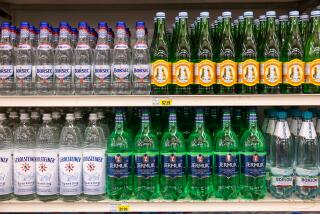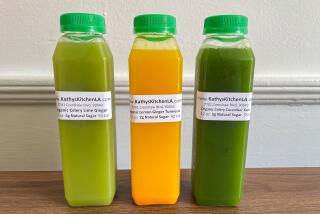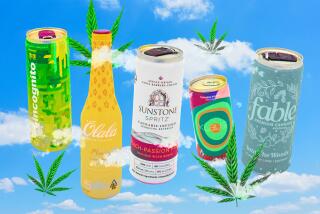Hansen Soda Company Bubbling Over With Possibilities : Retailing: The beverage maker says it is well positioned to take advantage of the trend toward ‘New Age’ drinks.
- Share via
ANAHEIM — The head of Hansen Natural Corp. couldn’t be happier with the fact that competitors’ “New Age” beverages are flooding the nation’s markets.
In the advertising blitzes for Snapple, Crystal Pepsi and Coca-Cola’s Nordic Mist, Hansen Chairman Rodney Sacks sees a sparkling opportunity: a sharper consumer focus on all New Age drinks, including Hansen’s Natural sodas.
The loosely defined category includes iced teas, flavored waters and “natural” sodas that generally are viewed as healthier alternatives to regular colas. Pepsi, Coke and dozens of other competitors are fighting for the New Age market share because those beverages are the fastest-growing segment of the soft-drink industry.
As Sacks sees it, Hansen is positioned to grab an increased share of the segment, which accounts for $1 billion of the $50-billion soft drink industry’s annual revenue. Sales of Hansen sodas and apple juice totaled $21.3 million for 1992.
Hansen executives do not expect to match the marketing might of upstart Snapple, whose iced teas generated $232 million in 1992 revenue. Nor do they hope to immediately top Clearly Canadian, which sold $150 million worth of flavored sparkling water last year. But industry analysts say that Hansen, based in Anaheim, can increase market share by keeping its costs low and recapturing some of the momentum that pushed Hansen’s sales to an estimated $50 million during the mid-1980s.
Nearly 15 years ago, founder Tim Hansen combined unusual flavors with clever marketing to turn the line of Hansen sodas and pasteurized juice products into a California favorite. That history of success gives Hansen a special marketing position, says Paul Gillette, a beverage industry analyst in Los Angeles.
“The idea has been that Hansen wasn’t so much formulated as blended from natural products,” Gillette says. “A lot of people perceive it as a healthier beverage” than its cola competitors.
“If Hansen can continue that unique selling proposition” nationwide, Gillette says, “it should go right through the roof.”
That California connection may be one of Hansen’s marketing strengths. Urban violence, earthquakes and a stalled economy may have dulled the Golden State’s image, but Sacks contends that consumers still look to Californians to set the next healthy trend. That’s why newly designed beverage cans will boldly identify Hansen’s Natural as “California’s original clear natural soda.”
Analysts are more skeptical about how helpful that California focus will be. They note, though, that Hansen is not alone in using real or imagined geographical roots to project a certain image.
Clearly Canadian, based in Vancouver, Canada, unabashedly incorporates Canada’s outdoor images into its marketing. And Coca-Cola Co., one of the world’s savviest marketers, has borrowed liberally from Scandinavia’s health consciousness for its new Nordic Mist beverage line.
Hansen executives also hope to build on the “good for you” image that was at the heart of the advertising and marketing concocted by founder Hansen in the late 1970s.
Hansen is the grandson of Hubert Hansen, who founded a juice company in Los Angeles in 1935. The Hansen family, which still distributes its own line of fresh, non-pasteurized juices from a plant in Azusa, licensed Tim Hansen to use the family name on a free-standing line of colas and pasteurized apple juice.
Hansen correctly identified growing consumer demand for clear, light-tasting sodas. But an ill-fated expansion forced the company into bankruptcy in 1988.
Sacks and a group of fellow investors assumed control of the firm in July, 1992, buying it from California CoPackers Corp.,a Hawaiian company that had purchased Hansen’s assets through Bankruptcy Court. Hansen Natural Corp. now trades on the NASDAQ market.
Hansen’s turnaround--it reported an $83,123 profit on $4.5 million in revenue for the first quarter this year--was orchestrated in large part by a management team with solid experience in the soft-drink industry. President Harold C. Taber Jr., for example, spent 27 years with subsidiary Coca-Cola Bottling Co. in Los Angeles.
Yet compared to fast-growing Snapple, Hansen is moving toward national distribution at a snail’s pace. The company, which has about two dozen employees, keeps costs low by contracting out most operations. Independent “flavor houses” develop new concoctions. Concentrate for soda and apple-juice products is blended at independent plants and delivered to licensed bottlers and packers by independent trucking companies.
Although Hansen is expanding its product line to include iced teas, lemonades and a sparkling water, the soda and apple juice lines will continue to be the mainstays.
Sacks, a 43-year-old native South African, acknowledges that Hansen can’t match the marketing prowess of Coke or Pepsi. And he is keenly aware that Snapple, based in Long Island, N.Y., is reported to be spending $30 million this year for advertising and marketing--more than Hansen’s total 1992 revenue.
Industry observers, however, say that Hansen’s slow-growth approach could pay long-term dividends if the company, by holding down costs, can undercut competitors when the inevitable price wars break out.
“I like where the company is at,” says Tom Pirko, a Los Angeles beverage industry consultant who made an unsuccessful bid to buy Hansen several years ago. “They’re at the right place at the right time. . . . The key is ultimately going to be pricing. And cost is going to become more and more important.
“Whether or not they can escape from being a regional (company) is ultimately going to depend on whether they can kick in some good-sized bucks,” Pirko said. “But as it stands now, they’re a good, profitable company.”
More to Read
Inside the business of entertainment
The Wide Shot brings you news, analysis and insights on everything from streaming wars to production — and what it all means for the future.
You may occasionally receive promotional content from the Los Angeles Times.










